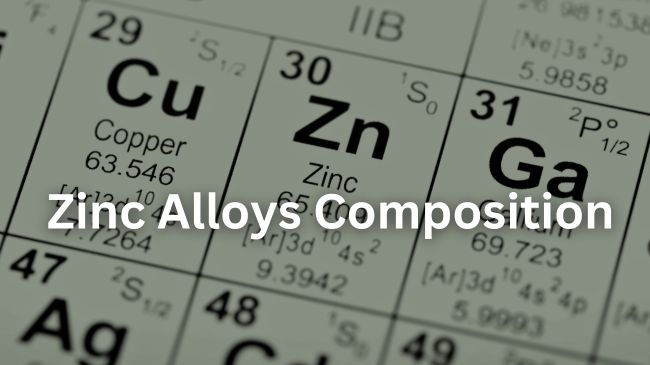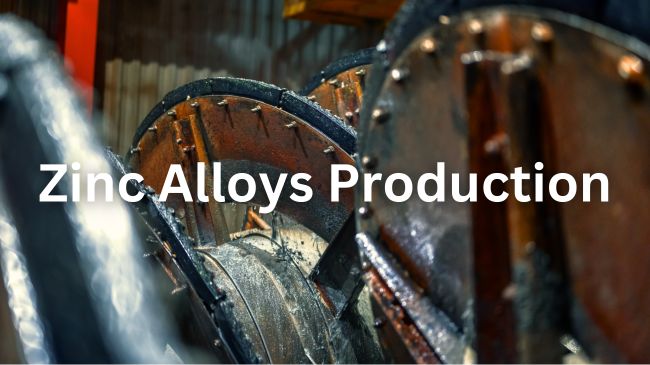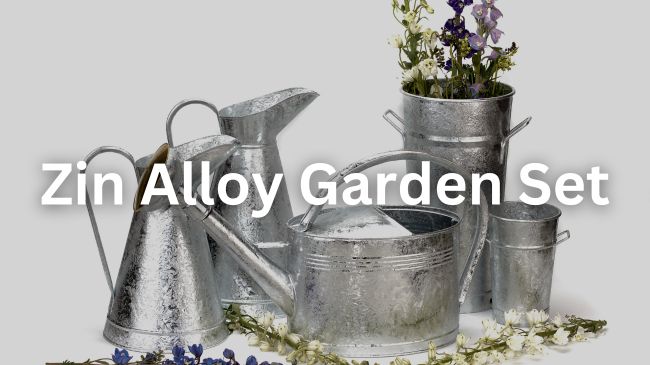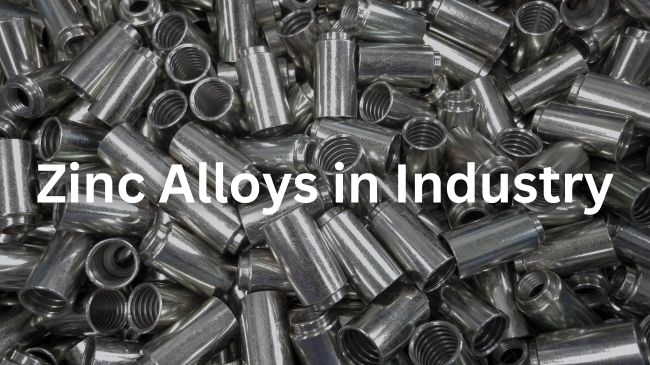Zinc alloys are versatile materials that have gained widespread popularity across various industries due to their unique combination of properties and adaptability.
In this blog post, we will delve deep into the world of zinc alloys, exploring their composition, production processes, casting methods, industrial applications, and sustainable aspects.
What is Zinc Alloy?
Zinc alloys are metals composed primarily of zinc, combined with other elements to enhance specific properties.
The addition of these alloying elements allows for the modification and optimization of the mechanical, physical, and corrosion-resistant characteristics of pure zinc, making it suitable for a wide range of applications.
Composition of Zinc Alloys

Zinc alloys typically consist of zinc as the primary metal, with varying amounts of alloying elements such as:
- Aluminum: Improves the strength, hardness, and castability of zinc alloys. Aluminum content in zinc alloys typically ranges from 4% to 27%.
- Copper: Enhances the strength, hardness, and corrosion resistance of zinc alloys. Copper content usually varies between 0.5% to 3%.
- Magnesium: Increases the ductility and impact resistance of zinc alloys. Magnesium content is typically between 0.01% to 0.05%.
- Iron: Improves the creep resistance and dimensional stability of zinc alloys. Iron content is usually limited to less than 0.1%.
- Lead: Enhances the machinability of zinc alloys but is being phased out due to environmental and health concerns. Lead content, when present, is typically less than 0.005%.
The specific composition of a zinc alloy is carefully selected to achieve the desired properties and to match the requirements of the intended application. This customizability ensures that zinc alloys can meet the specific demands of various industries.
Properties of Zinc Alloys
Zinc alloys exhibit a combination of properties that make them attractive for various applications:
Mechanical Properties:
- High tensile strength (up to 400 MPa)
- Good hardness (80-120 HB)
- Excellent dimensional stability
- Good impact resistance
Physical Properties:
- Low melting point (around 380-390°C or 716-734°F)
- High thermal and electrical conductivity
- Good fluidity for casting
- Relatively low density (6.6-7.1 g/cm³)
Corrosion Resistance:
- Excellent corrosion resistance in atmospheric conditions
- Good resistance to water, alkalis, and organic chemicals
- Susceptible to acidic environments
The specific properties of a zinc alloy can be tailored by adjusting the composition and the manufacturing process to suit the requirements of a particular application.
This versatility has made zinc alloys a popular choice in various industries, including automotive, electrical, construction, and consumer goods.
Production and Processing of Zinc Alloys

Zinc alloys are produced and processed using two main methods: pyro-metallurgical and hydrometallurgical processes.
Pyro-metallurgical Process
The pyro-metallurgical process involves the use of high temperatures to extract and purify zinc from its ores. The main steps in this process are:
- Roasting: Zinc ores, such as sphalerite (ZnS), are roasted in the presence of air at temperatures around 900-1000°C (1652-1832°F). This converts the zinc sulfide to zinc oxide (ZnO) and removes impurities like sulfur dioxide.
- Smelting: The roasted zinc oxide is then smelted in a furnace, such as a vertical retort furnace or an imperial smelting furnace, at temperatures around 1100-1300°C (2012-2372°F). This reduces the zinc oxide to molten zinc, which is collected at the bottom of the furnace.
- Alloying: The molten zinc is then combined with other alloying elements to produce the desired zinc alloy composition.
Hydrometallurgical Process
The hydrometallurgical process, also known as the electrolytic process, involves the use of aqueous solutions to extract and purify zinc. The main steps in this process are:
- Leaching: Zinc ores are leached with a suitable reagent, such as sulfuric acid, ammonia, or sodium hydroxide, to dissolve the zinc and form a zinc-rich solution.
- Purification: The zinc-rich solution undergoes various purification stages, such as cementation, solvent extraction, or ion exchange, to remove impurities and achieve the desired purity level.
- Electrolysis: The purified zinc solution is subjected to electrolysis, where an electric current is passed through the solution, causing the zinc to deposit on the cathode as high-purity metallic zinc (99.99% or higher).
- Alloying: The high-purity zinc is then melted and combined with other alloying elements to produce the desired zinc alloy composition.
Introduction to Zinc Casting Alloys
Zinc casting alloys are categorized into two main families: ZAMAK alloys and ZA alloys, each developed to meet specific industrial needs.
ZAMAK Alloys
Developed in the 1920s specifically for pressure die casting, ZAMAK alloys are a well-established group of zinc casting materials.
These alloys are identified by their numerical designations and are renowned for their balance of mechanical properties and ease of casting. The key ZAMAK alloys include:
- ZAMAK 3: This is the most widely used ZAMAK alloy, accounting for over 70% of all North American zinc die castings. ZAMAK 3 is favored for its excellent castability, high strength, and good surface finish, making it suitable for a wide range of applications.
- ZAMAK 5: ZAMAK 5 offers improved mechanical properties and corrosion resistance compared to ZAMAK 3. It is chosen for applications requiring additional strength and durability, although it is slightly less easy to cast than ZAMAK 3.
- ZAMAK 7: Known for providing the highest strength among the ZAMAK alloys, ZAMAK 7 also maintains good castability and dimensional stability, making it ideal for demanding applications.
- ZAMAK 2: Although less commonly used, ZAMAK 2 provides the highest hardness and strength among the ZAMAK alloys. It is used in applications that require these specific properties.
ZA Alloys
ZA alloys, developed in the 1970s, are a more recent addition to the family of zinc casting alloys.
These alloys have higher aluminum content, which enhances their mechanical properties and provides excellent bearing characteristics. The primary ZA alloys include:
- ZA-8: This alloy has a higher aluminum content than ZAMAK alloys, giving it superior bearing properties and strength. ZA-8 is used in applications where these properties are critical.
- ZA-12: ZA-12 strikes a balance between ZA-8 and ZA-27, offering good bearing properties, moderate strength, and good castability. It is suited for a variety of industrial applications.
- ZA-27: Known for its high aluminum content, ZA-27 provides excellent mechanical properties, including high strength and wear resistance. It is used in applications requiring maximum performance in terms of durability and load-bearing capacity.
Both ZAMAK and ZA alloys are widely used in die casting, a process where molten metal is injected into a mold under high pressure to produce complex shapes with high precision and minimal post-processing.
The choice between these two families of alloys depends on the specific requirements of the application, including mechanical properties, durability, and ease of casting.
The versatility and efficiency of these zinc casting alloys make them indispensable in the mass production of high-quality components across various industries.
Applications of Zinc Alloys
Zinc alloys are utilized across a broad spectrum of industries due to their unique combination of mechanical properties, corrosion resistance, and cost-effectiveness. Here are some of the key applications of zinc alloys:
Automotive Industry
In the automotive sector, zinc alloys are extensively used to manufacture various components due to their high strength, durability, and excellent castability. Key applications include:
- Engine Parts: Zinc alloys are used to produce carburetors, fuel pumps, and other engine components that require precision and strength.
- Chassis Components: Parts such as brackets, mounts, and housings are often made from zinc alloys due to their ability to withstand mechanical stress and environmental conditions.
- Interior Components: Zinc alloys are used for producing door handles, knobs, and other interior fittings that require a good surface finish and durability.
Electrical and Electronics Industry
Zinc alloys play a crucial role in the electrical and electronics industry, providing reliable and durable solutions for a variety of applications:
- Connectors and Terminals: The excellent electrical conductivity and corrosion resistance of zinc alloys make them ideal for connectors, terminals, and other electrical components.
- Housings and Enclosures: Zinc alloys are used to produce robust and precise housings for electronic devices, ensuring protection and durability.
Construction Industry
In construction, zinc alloys are valued for their strength, corrosion resistance, and ease of fabrication. Some common applications include:
- Architectural Hardware: Zinc alloys are used to manufacture door locks, hinges, and other architectural hardware that require durability and aesthetic appeal.
- Structural Components: Certain structural elements, such as brackets and supports, are made from zinc alloys to provide strength and longevity.
Consumer Goods

The consumer goods industry leverages the versatility and aesthetic qualities of zinc alloys for a wide range of products:
- Appliances: Components of household appliances, such as washing machines and refrigerators, are made from zinc alloys to ensure reliability and longevity.
- Decorative Items: Zinc alloys are used to create decorative items, including jewelry, statuettes, and home décor, due to their ability to be cast into intricate shapes and finished to a high standard.
Medical Devices
In the medical field, zinc alloys are used to produce various devices and components due to their biocompatibility and precision:
- Surgical Instruments: Certain surgical tools and devices are made from zinc alloys, providing the necessary strength and precision.
- Medical Equipment: Components of medical equipment, such as housings and fittings, benefit from the durability and corrosion resistance of zinc alloys.
Aerospace Industry
The aerospace sector utilizes zinc alloys for components that require high strength-to-weight ratios and precision:
- Aircraft Components: Zinc alloys are used in the production of specific aircraft parts, such as brackets and housings, where strength and durability are paramount.
Telecommunications
In telecommunications, zinc alloys are employed to manufacture components that require high precision and corrosion resistance:
- Antenna Components: Zinc alloys are used for producing parts of antennas and other communication devices, ensuring long-term performance and reliability.
Why are Zinc Alloys Popular in Industrial Applications?

Zinc alloys have gained widespread popularity in various industrial applications due to several key factors:
- Cost-effectiveness: Zinc is relatively abundant and less expensive compared to other metals, making zinc alloys an economical choice for mass production.
- Excellent castability: The low melting point and good fluidity of zinc alloys enable the production of intricate and precise components with minimal defects.
- High strength and durability: The addition of alloying elements significantly enhances the mechanical properties of zinc, resulting in strong and durable components.
- Corrosion resistance: Zinc alloys offer good resistance to corrosion, making them suitable for applications in harsh environments.
- Versatility: Zinc alloys can be used in a wide range of applications, including automotive parts, electrical components, consumer goods, and decorative items.
These factors contribute to the widespread adoption of zinc alloys in industries that demand high performance and reliability.
Sustainable Aspects of Zinc Alloys
Zinc alloys offer several sustainable advantages:
- Recyclability: Zinc alloys are highly recyclable, and scrap metal from manufacturing processes and end-of-life products can be re-melted and reused without significant loss of quality.
- Energy efficiency: The low melting point of zinc alloys requires less energy for processing compared to other metals, reducing the overall carbon footprint.
- Durability: The high strength and corrosion resistance of zinc alloys contribute to longer product lifespans, reducing the need for frequent replacements and conserving resources.
- Reduced waste: Advanced casting techniques and precise manufacturing processes minimize waste generation, making zinc alloys a more sustainable option.
By leveraging these sustainable aspects, industries can reduce their environmental impact and promote a more circular economy.
Zinc alloys are remarkable materials that offer a combination of excellent properties, cost-effectiveness, and sustainability. Their versatility has made them indispensable in various industrial applications, from automotive components to consumer goods.
As technology advances and new applications emerge, zinc alloys will undoubtedly continue to play a crucial role in shaping the world around us.
